

The Global Innovation Lab for Climate Finance. BestRes. Minder kosten, meer comfort. New York Power Authority. K-Solar. K-Solar Overview. De btw-gevolgen van subsidies. Een subsidie kan worden omschreven als een door een overheid of een derde verleende geldelijke tussenkomst, voor het financieren van werkzaamheden waarvan geoordeeld wordt dat ze nuttig zijn voor ‘het algemene welzijn’.
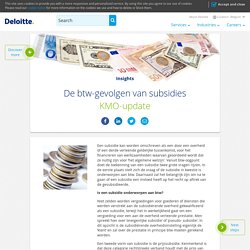
Vanuit btw-oogpunt doet de toekenning van een subsidie twee grote vragen rijzen. In de eerste plaats stelt zich de vraag of de subsidie in kwestie is onderworpen aan btw. Daarnaast zal het belangrijk zijn om na te gaan of een subsidie een invloed heeft op het recht op aftrek van de gesubsidieerde. Is een subsidie onderworpen aan btw? Cahier des charges-type pour le Tiers-investissement en solaire photovoltaïque — S.L.R.B. - B.G.H.M. La Wallonie soutient la recherche en énergie - Portail de l'énergie en Région wallonne. I.
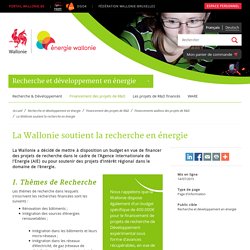
Thèmes de Recherche Les thèmes de recherche dans lesquels s'inscrivent les recherches financées sont les suivants : Rénovation des bâtiments ; Intégration des sources d'énergies renouvelables ; Intégration dans les bâtiments et leurs micro-réseaux ;Intégration dans les réseaux d'électricité, de gaz (réseaux de distribution et de transmission) et de chaleur. Les subventions et subsides en faveur des pouvoirs locaux bruxellois. Accueil - GRE-Liège. Que fait Financité ? EnerGent cvba. Op 4 december 2013 werden de statuten van EnerGent cvba neergelegd op het kantoor van notaris Stéphane Vander Eecken, Franklin Rooseveltlaan 23 in Gent.
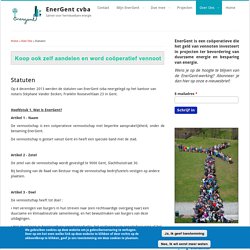
Hoofdstuk 1. Wat is EnerGent? Businessmodel groepsaanbod Energiezuinig wonen. 09 oktober 2012.
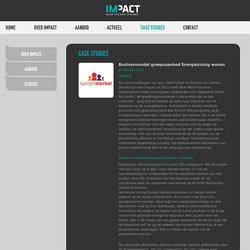
Collectieve inkoopacties niet altijd eerlijk. Steeds vaker worden er vraagtekens gesteld bij landelijke en regionale inkoopacties voor zonnepanelen.
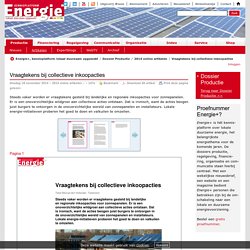
Er is een onoverzichtelijke wildgroei aan collectieve acties ontstaan. Dat is ironisch, want de acties beogen juist burgers te ontzorgen in de onoverzichtelijke wereld van zonnepanelen en installateurs. Lokale energie-initiatieven proberen het goed te doen en valkuilen te omzeilen. Pagina 1 1 Vraagtekens bij collectieve inkoopacties Tekst Manuel den Hollander, Toestroom 2012 Aeneas Steeds vaker worden er vraagtekens gesteld bij landelijke en regionale inkoopacties voor zonnepanelen. Hefboom - Home. Onthaal. MicroStart, klein krediet voor grote plannen!
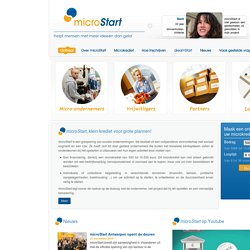
MicroStart is een groepering van sociale ondernemingen, die bestaat uit een coöperatieve vennootschap met sociaal oogmerk en een vzw. Ze heeft zich tot doel gesteld ondernemers die buiten het klassieke banksysteem vallen te ondersteunen bij het opstarten of uitbouwen van hun eigen activiteit door middel van: Een financiering, dankzij een microkrediet van 500 tot 15.000 euro.
Groene obligaties breken door (+Video) Als een organisatie (overheid, onderneming of instelling) geld nodig heeft, kan het dat onder meer bekomen door het uitgeven van een obligatielening.
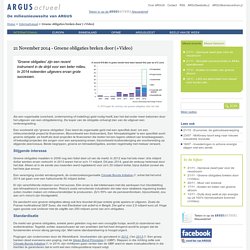
De koper van de obligatie ontvangt dan van de uitgever een rentevergoeding. Een voorbeeld zijn 'groene obligaties'. Dan leent de organisatie geld met een specifiek doel: om een milieuvriendelijk project te financieren. Bijvoorbeeld een bioboerderij. Quels outils pour une gestion durable de ma TPE/PME ? / Welke tools om mijn zeer kleine onderneming of kmo duurzaam te beheren? Quels outils pour une gestion durable de ma TPE/PME ?
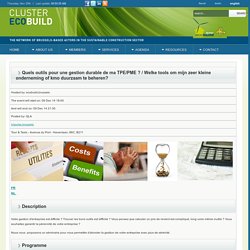
/ Welke tools om mijn zeer kleine onderneming of kmo duurzaam te beheren? Description Votre gestion d'entreprise est difficile ? Trouver les bons outils est difficile ? Vous pensez que calculer un prix de revient est compliqué, long voire même inutile ? Déclaration de créance: mode d'emploi. Les bénéficiaires d'une subvention de la DGO4, dans le cadre d'un projet de recherche, doivent remettre une déclaration de créance semestrielle au gestionnaire technique du dossier.
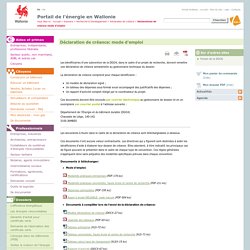
1064.pdf. E-Report : Nouvelles procédures de traitement des dossiers de créance dans le cadre des "aides générales" Cette notice introductive a pour but de vous familiariser avec la nouvelle procédure de rentrée des dossiers de créance dans le cadre de votre convention de recherche.
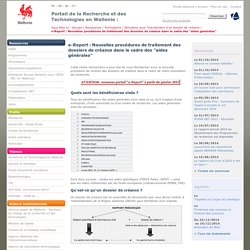
Quels sont les bénéficiaires visés ? Tous les bénéficiaires des aides générales sont visés et ce, qu'il s'agisse d'une entreprise, d'une université ou d'un centre de recherche. Les aides générales sont les suivantes : Sont donc exclues : toutes les aides spécifiques (FIRST, Patex, DIFST...) ainsi que les aides cofinancées par les fonds européens (cofinancements FEDER, FSE). Qu'est-ce qu'un dossier de créance ? Un dossier de créance est un ensemble de documents que vous devez rentrer à l'administration de la Région wallonne (DGO6) pour bénéficier d'un subside.
ATTENTION : S'il manque un document, votre créance n'est pas éligible. Welkom. Fonds Bruxellois de garantie. Energieagentur Regio Freiburg: About us. ECO-Watt-Project_english.pdf. H2020 Calls - Research Participant Portal. Research & Innovation - Participant Portal Search Online services unavailable Search Topics Calls Call Updates Research Fund for Coal & Steel 3rd Health Programme Consumer Programme Calls Call Updates Other Funding Opportunities © European Communities. PDA-FAQ-v1.pdf. How we measure our impact.
The Low Carbon Hub plans to measure our progress annually against four sets of indicators. This measurement framework is being developed with the support of Resonance Ltd and is not yet complete but gives you an idea of how it is shaping up. We will publish the results as part of our normal annual reporting process. EeB-08-2015. EE-21-2015. Specific challenge: The public sector has an exemplary role to play (in particular as regards the management of public assets) in addressing the market deficiencies[1] by setting a stable regulatory environment and by engaging in dialogue with the key stakeholders to improve the legal and financial framework and to put in place innovative financing schemes. However, the deployed public funds have to be matched and multiplied by private sector capital, to address the financing gap.
The energy services industry together with the financial sector also need to develop and roll out new business models in order to better monetise future energy savings and tackle new sectors with the aim of reaching a potential turnover of some EUR 25 billion per year[2]. EE-20-2015. Specific challenge: Significant efforts are required to mobilise all relevant stakeholders, draw up investment inventories, develop feasibility studies, financial engineering instruments, and to address legal and procurement issues.
In this context, it is necessary to support project promoters through dedicated project development assistance facilities and capacity building and thus demonstrate the viability and positive impacts of aggregated, sustainable energy investments. Scope: Project development assistance support will be provided to public and private project promoters such as public/private infrastructure operators, energy service companies (ESCOs), retail chains, cities and SMEs/industry, leading to innovative, bankable and aggregated sustainable energy investment schemes and projects of EUR 6 million – EUR 50 million.
The support will be conditional on mobilized investments. Type of action: Coordination and Support Actions [2] www.eib.org/elena. EeB-08-2015. Specific challenge: Europe is facing the challenge of deep rehabilitation of residential buildings (including buildings of historic value) while lowering the costs of refurbishment. Nowadays at the scale of Europe, fossil energy is mainly used in residential buildings for two usages which are space heating and Domestic Hot Water production. Such a large building stock needs innovative, efficient and cost-effective retrofitting solutions to meet the planned net-zero energy standards. Moreover, due to the current economic crisis investment capability in building retrofitting is limited and public incentives tend to decrease.
Breakthrough solutions are, therefore, needed which combine affordability along the whole life cycle, reduced maintenance and higher performance reliability with reduced energy use. EE-02-2015. Specific Challenge: By the end of 2020 (2018 for buildings occupied and owned by public authorities), all new buildings should comply with the Energy Performance of Buildings Directive obligations and thus meet 'nearly zero-energy' performance levels using innovative, cost-optimal technologies with integration of renewable energy sources on site or nearby.
The drive for nearly zero-energy buildings takes place in the context of the drive for new-buildings towards zero life-cycle material impacts. Moreover, the construction of 'plus-energy' buildings - i.e. buildings producing more energy than they consume - should also be encouraged in order to reduce energy use whilst increasing the share of renewable energies.
However the costs of these highly energy performing buildings still represent a barrier for investors. Therefore the construction industry needs to deliver more affordable solutions. Intelligent Energy Europe. The European Commission has set up a series of facilities funding Project Development Assistance (PDA) to support ambitious public authorities - regions, cities, municipalities or groupings of those - and public bodies in developing bankable sustainable energy projects. The PDA facilities aim to bridge the gap between sustainable energy plans and real investment through supporting all activities necessary to prepare and mobilise investment into sustainable energy projects. These activities can include feasibility studies, stakeholder and community mobilisation, financial engineering, business plans, technical specifications and procurement procedures. Eligible Investments - European Energy Efficiency Fund EEEF.
The European Energy Efficiency Fund (EEEF) targets investments in the member states of the European Union. The final beneficiaries of EEEF are municipal, local and regional authorities as well as public and private entities acting on behalf of those authorities such as utilities, public transportation providers, social housing associations, energy service companies etc. Investments can be made in Euro, or local currencies, however the latter is restricted to a certain percentage.
To reach its final beneficiaries, EEEF can pursue two types of investments: